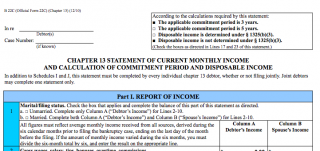When New Means Testing Numbers Matter
The United States Trustee publishes official means testing numbers, which are used to complete the bankruptcy means test. In chapter 7, the means test serves as an eligibility threshold, resulting in chapter 7 being unavailable to individuals with certain combinations of income and expense that on paper suggest an ability to pay creditors in chapter 13. In chapter 13, the means test influnences how long a chapter 13 plan runs and how much money, if any, is paid to general unsecured creditors (such as credit card debts).
The practice is for the United States Trustee to publish new means testing numbers twice annually, reflecting changes in the underlying data obtained from the census bureau and the internal revenue service. A few weeks lay between the publication of the new numbers and their effectiveness on new bankruptcy cases filed thereafter. For example, the UST published on October 12, 2012 a new set of numbers to be effective on November 1.
The few weeks between publication and effectiveness of the numbers provides an opportunity for a prospective bankruptcy filer and his or her attorney to choose a filing date and therefore a set of means testing numbers. For many debtors, the changes will make little difference. For other debtors on the margins, the effect of a change can be quite consequential. Two types of changes affect planning differently.
1. Median Income Levels
One can expect every new set of means testing figures to include updated household median income figures for each state, obtained from the census bureau. These levels might go up or down. In North Carolina, the recent trend has been for median income to go down for the fall and up for the spring. There is a time-lag built into the figures, as they reflect somewhat of a historical view on income. I will leave it to others to speculate as to what is the source of the seasonality in median income.
Means testing is a two-step process: (1) determine whether the household is above median income where the means test applies and (2) determine whether expense allowances consume all income or not. When the median level changes, the result is a change as to which people have to complete the means test.
Accordingly, the semi-annual median income adjustment matters to people whose income is very close to the median level. For these people, filing on the correct side of the change can mean avoiding the means test altogether. That might mean a simpler or shorter bankruptcy.
2. Expense Allowances
The expense allowances are computed by the IRS, where the allowances are used in the tax collection process. They are updated less frequently than the median income levels. However, when they change, they tend to affect a large swath of above median cases. Unlike the median income level, which is used as a threshold, the allowances are deductions. So a $1 change in allowance impacts every person claiming the allowance, not just the person at the margin.
For the most part, expense allowances go up, although there have been some exceptions. When expense allowances increase, they benefit debtors by allowing more expenses to be claimed. Waiting for an increased allowance to go into effect might reduce a chapter 13 payment or support a better case for chapter 7 eligibility.
With more than 7 years now since the effective date of BAPCPA and requirements such as means testing, means testing changes have become somewhat old news. Keeping informed of changes remains important when carefully timing the filing of a bankruptcy case.
- Log in to post comments




